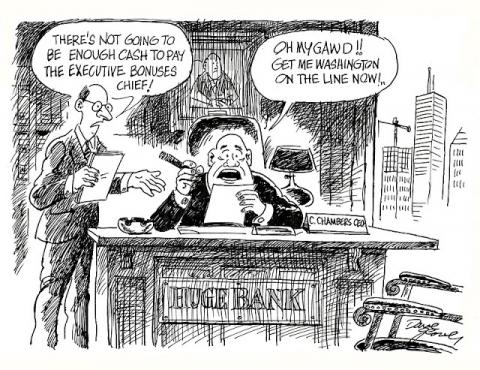The New York financial industry's bonus pool exceeded the annual earnings of the more than 1 million Americans who work full-time at the federal minimum wage.

Wall Street banks handed out $26.7 billion in bonuses to their 165,200 employees last year. That amount would be enough to more than double the pay for all 1,085,000 Americans who work full-time at the current federal minimum wage of $7.25 per hour.
Purveyors of luxury goods always welcome the Wall Street bonus season, but a raise in the minimum wage would give America’s economy a much greater boost. To meet basic needs, low-wage workers tend to spend nearly every dollar they make. The wealthy can afford to squirrel away more of their earnings.
All those dollars low-wage workers spend create an economic ripple effect. Every extra dollar going into the pockets of low-wage workers, standard economic multiplier models tell us, adds about $1.21 to the national economy. Every extra dollar going into the pockets of a high-income American, by contrast, only adds about 39 cents to the GDP.
These pennies add up considerably on $26.7 billion in earnings. If the $26.7 billion Wall Streeters pulled in on bonuses in 2013 had gone to minimum wage workers instead, our GDP would have grown by about $32.3 billion, over triple the $10.4 billion boost expected from the Wall Street bonuses.
This immense GDP differential only speaks to one price we pay for our contemporary Wall Street bonus reward culture. Huge bonuses, we learned from the 2008 financial industry meltdown, create an incentive for high-risk behaviors that endanger the entire economy. And regulators have failed to implement a provision in the 2010 Dodd-Frank financial reform legislation to prohibit financial industry pay packages that encourage “inappropriate risks.”
Low-wage jobs, on the other hand, endanger nothing. Concentrated in agriculture, hospitality, and retail, these jobs provide real services. They deserve much higher minimal rewards.


Sources and Methodology:
Wall Street bonuses: New York State Comptroller
Full-time minimum wage workers (working full-time 35 or more hours per week): most recent Bureau of Labor Statistics data for 2012.
Combined annual earnings of all full-time minimum wage workers: Calculated by the author based on $7.25 per hour for 37 hours per week for 52 weeks.
Economic multipliers: Based on the macroeconomic multipliers calculated by Moody’s Analytics Chief Economist Mark Zandi, which estimate the one-year dollar change in GDP for a given dollar reduction in federal tax revenue. For the low-wage worker multiplier, we followed a methodology developed by the Economic Policy Institute and averaged Zandi’s stimulus multipliers for the Earned Income Tax Credit (within the parameters of the American Recovery and Reinvestment Act) and Making Work Pay (ARRA’s refundable tax credit for working individuals and families) for a multiplier of 1.21. For the high-income multiplier, we used Zandi’s multiplier for dividend and capital gains tax cuts, for a multiplier of 0.39. Capital gains are heavily concentrated among very high-income individuals. According to the Tax Policy Center, the top 1 percent of taxpayers received 71 percent of all capital gains in 2012.


Spread the word